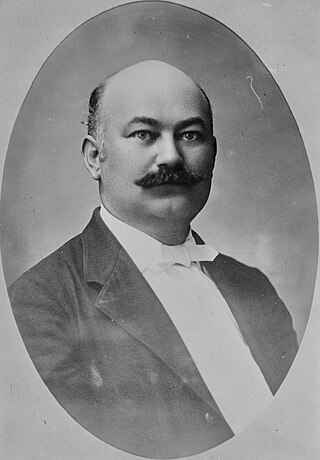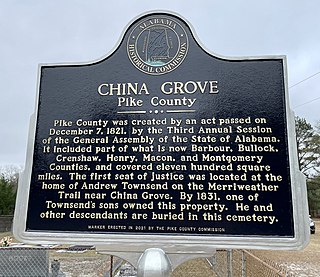
Montgomery County is located in the State of Alabama. As of the 2020 census, its population was 228,954, making it the fifth-most populous county in Alabama. Its county seat is Montgomery, the state capital. Montgomery County is included in the Montgomery, AL Metropolitan Statistical Area.

Pike County is located in the U.S. state of Alabama. As of the 2020 census the population was 33,009. Its county seat is Troy. Its name is in honor of General Zebulon Pike, of New Jersey, an explorer who led an expedition to southern Colorado and discovered Pikes Peak in 1806.

Eufaula is the largest city in Barbour County, Alabama, United States. As of the 2010 census the city's population was 13,137.

Troy is a city in and the county seat of Pike County, Alabama, United States. It was formally incorporated on February 4, 1843.

Charles Henderson was an American businessman serving as the 35th Governor of Alabama from 1915 to 1919 and a member of the Democratic Party. Before serving as governor, Henderson was mayor of Troy, Alabama from 1886 to 1906 and played a role in Troy's business and civic development. After his term as governor, Henderson remained active in the community. In 1937, after a bout with influenza, Henderson suffered a stroke and died at age 76. The public high school and middle school in Troy bear his name.

The United States District Court for the Middle District of Alabama is a federal court in the Eleventh Circuit.
Jeremiah Augustus ("Gus") Henderson was a businessman and captain of the Confederate army from Gainers Store, Alabama. His sons include Charles Henderson, former governor of Alabama, and Fox Henderson, a successful banking and business entrepreneur.

Eugene Allen Smith was an American geologist.
Orion, also known as Prospect Ridge, is an unincorporated community in Pike County, Alabama, United States, located 12.9 miles (20.8 km) north of Troy.

Edwin is an unincorporated community in Henry County, Alabama, United States.
Clintonville, also known as Indigo Head, is an unincorporated community in Coffee County, Alabama, United States. Clintonville is located at the junction of Alabama State Route 51 and Alabama State Route 122, 2.5 miles (4.0 km) northeast of New Brockton.

China Grove is an unincorporated community in Pike County, Alabama, United States, located 15 miles (24 km) north of Troy.
Garland is an unincorporated community in Butler County, Alabama, United States, located 6 miles (9.7 km) west of McKenzie.
Riderwood is an unincorporated community in Choctaw County, Alabama, United States.
Josie – also known as Upper Josie – is an unincorporated community in Pike County, Alabama, United States. It was named for Josie Lawson, who was the daughter of local merchant Joe Lawson. Josie was formerly served by a local school. A post office operated under the name Josie from 1881 to 1907.

Shady Grove, also known as Chesser, is an unincorporated community in Pike County, Alabama, United States.

The 1831 Alabama gubernatorial election was an election held on August 1, 1831, to elect the governor of Alabama. Jacksonian candidate John Gayle beat the incumbent Jacksonian governor Samuel B. Moore and National Republican candidate Nicholas Davis with 55.01% of the vote.
Tennille, also spelled as Tennile is an unincorporated community in Pike County, Alabama. It is located 17 miles southeast of Troy, Alabama.

Fort Madison was a stockade fort built in August 1813 in present-day Clarke County, Alabama, during the Creek War, which was part of the larger War of 1812. The fort was built by the United States military in response to attacks by Creek warriors on encroaching American settlers. The fort shared many similarities to surrounding stockade forts in its construction but possessed a number of differences in its defenses. The fort housed members of the United States Army and settlers from the surrounding area, and it was used as a staging area for raids on Creek forces and supply point on further military expeditions. Fort Madison was subsequently abandoned at the conclusion of the Creek War and only a historical marker exists at the site today.















